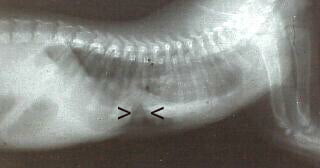Although more needs to be known about dwarf cat health issues, this group of short-legged cats are said to be generally healthy partly because of careful breeding. However, there are two health problems which are known to exist in dwarf cats. They are present in the founding dwarf cat, the Munchkin. All dwarf cat breeds carry the Munchkin genes. The health issues mentioned below are congenital i.e. inherited diseases. Because they are inherited it has to be argued that dwarf cats are less healthy than regular moggies.

Lordosis
This is an inward curvature of the spine. The spine drops inwards around the shoulder blades. It causes misalignment in the thoracic region of the spine, which is the upper part of the spine including the vertebrae connected to the ribs.
As the spine dips it compresses the heart, lungs and trachea. In severe conditions the kitten dies at 10-11 weeks of age. Kittens appear swaybacked or humpbacked. In mild cases it can cause infections, breathing and cardiac distress and pneumonia. In mild versions of this condition the cat can live a normal life.
Pectus excavatum
This is also a congenital deformity. In a healthy cat the chest cavity is oval while in a cat suffering from pectus it is narrower from top to bottom and the sternum is displaced upwards (see on this page).

In severe cases of pectus the reduced chest space results in the compression of the heart and lungs. This leads to an aversion to exercise, coughing, weight loss, failure to gain weight and breathing difficulties.
Prevalence
We don’t know the prevalence of the above congenital conditions. More work needs to be done. I presume that dwarf cat breeders do their utmost to breed out these conditions, which they refer to as ‘LP’ (Lordosis Pectus). Clearly, therefore, they are a notable issue in their breeding programs. They are rarely spoken about.
Humans
Both these conditions are also seen in humans.
Pseudoachrondroplasia
The founding dwarf breed, the Munchkin, has a normal head and body but short limbs and therefore it has been decided that this breed suffers from a condition called pseudoachondroplasia (source: Sarah Hartwell). The two health conditions referred to above are associated with this form of dwarfism.
P.S Dwarf cat owners say dwarf cats jump almost as well as normal cats.
Sources: Various – please click on this link and go to the base of the page.

There are different causes of small stature in cats, not just the disease genes bread for in “Munchkins”. There is Feline Pituitary Dwarfism (Hyposomatotrophism), amongst other conditions, some probably yet unknown. Not every diminutive cat tests out as having one of these particular disorders.
bred
I adopted a rescue. Noticed the short legs and tail I believe she is a dwarf kitty. Love her and want to know if she will have health problems.
In general their health is okay it seems to me. The two health problems I mention are the known inherited ones. You should be okay. Also your cat might not have been bred by a breeder which may mean there is less chance that she has these potential health issues.
Its heartbreaking that breeders insist on continuing a breed regardless of the health issues involved. I feel so sorry for those animals.
I agree. If one wants a short legged fun animal, get a ferret. even daschunds, bred with a PURPOSE, to go into burrows or brush have a host of issues. Breeders of tiny ponies strive to avoid dwarfism and its attendant issues.
But we often see this kind of thing in anything we breed domestically: we exaggerate a characteristic to the point of Stupid and Dysfunctional (commercial turkeys and pigs who grow fast and can’t walk, brainless fast horses, over-hyper herding dogs).
Keeping the original model (the wild type) in mind when we breed would keep us on track.
Thanks a lot Teanna and I completely agree with you.
We had a dwarf kitten born to one of the old ferals many years ago. I bottle fed this one for quite a while as it didn’t thrive. We called her Astro and it was before I had house cats. I had someone offer quite a lot of money for her to use for breeding. I refused based on her obvious issues.
Awesome response! I feel these kinds of mutations should not be bred.
I spent 30 plus years breeding sport horses that were sound of mind and body. Most people who get a pet do not need and are not inclined or capable of caring for a special needs animal.
Astro was a sweet little cat who often rode around in my coat pocket or inside my coat with the drawstring pulled. She was never really healthy.
I never bred a mare unless the stallion owner wanted to evaluate my mare or bred a mare that did not meet or exceed my standards. Pet breeders who are looking for the next fashion trend sorta , ok really make me sick.